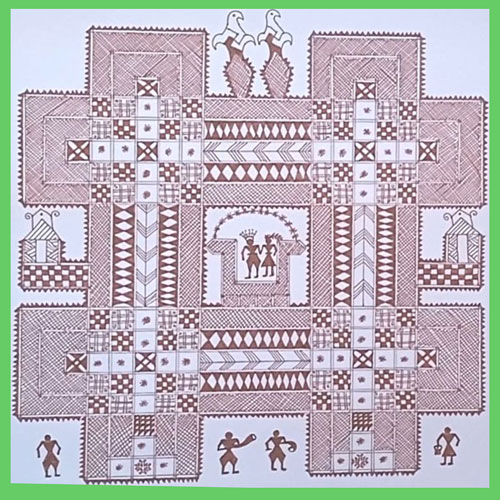Chittara art is a traditional and culturally significant art form rooted in the Deevaru community of Karnataka, India. This matriarchal, agrarian community of nature worshippers resides in and around the Sagar district and has a longstanding history with this form of artistic expression, spanning over 500 years. The art is primarily created by the women of the community and serves as a socio-cultural practice that encapsulates the dynamic aspects of their heritage.
Origins and Characteristics
Chittara art has its origins in the ancient tribal art forms of Karnataka, with its roots possibly tracing back to cave paintings from 9000 years ago. The word “Chittara” itself, in the Kannada dialect, refers to an image or design. Traditionally, this art form is executed on walls, floors, and furniture within village homes using natural pigments and materials.
Colors and Techniques
The primary colors used in Chittara art are white, black, and red, while other vibrant hues may also be utilized occasionally. Natural sources such as ground white rice, flour, turmeric powder, lime powder, and mud provide the pigments for these paintings. The preparation process involves transforming powdered pigments into a thin paste-like consistency by adding water, ensuring that the colors are suitable for application.
Symbolism and Styles
Chittara art is rich in symbolism, with straight lines and symmetrical designs forming the basis of its unique aesthetic. This art form tells stories from Hindu epics such as the Ramayana and Mahabharata, depicting scenes of bravery, reconciliation, and traditional Indian culture. The style is characterized by its use of straight lines, eschewing curves or angles, and requiring a precise understanding of ratios and proportions.
Preservation and Modern Adaptations
As the world becomes increasingly digitized, traditional Chittara artisans face challenges in transitioning their practices. However, recognition and support from homegrown organizations have given the Deevaru women opportunities to exhibit their work and host workshops to promote the art form. Additionally, their handicrafts are now available in shops across Bengaluru and Chennai.
Despite the hurdles, the Deevaru women and contemporary artists are dedicated to preserving and evolving Chittara art, ensuring its continuity and relevance for future generations.
Available Research Papers on Chittara Art
- In the InSEA – 2007. Asian Regional Congress Seoul – South Korea. (Internationally society for Education through Art).
- International conference on Asia Pacific Art Education – 2007, National Hualien University of Education, Taiwan.
- Art works and posters on this art practice were also exhibited at The International conference on Asia Pacific Art Education – 2007, National Hualien University of Education, Taiwan.
- Analysis of art education and Chittara were presented at Panel discussion at The International conference on Asia Pacific Art Education – 2007, National Hualien University of Education, Taiwan.
- InSEA – World Congress, Osaka, Japan 2008.
FAQ on Chittara Art
Chittara art is a traditional tribal art form from the Deevaru community in Karnataka, India. It involves creating geometric patterns using natural materials such as clay paste on the floors and walls of entrances of houses. Originating from ancient cave paintings, Chittara art eventually transitioned to being practiced in village homes.
Chittara murals were traditionally painted on the outer walls of homes on auspicious occasions to welcome deities during festivals and religious ceremonies such as weddings. This art form is deeply rooted in Karnataka’s cultural heritage, particularly among the Deevaru community.
Chittara art features intricate geometric patterns, including triangles, that are interconnected to create elaborate, repetitive designs. These geometric shapes may symbolize aspects of nature, mythology, or religious beliefs and require a precise understanding of ratios and proportions to execute.
Chittara art has been practiced by women of the Deevaru community in the Sagar district of Karnataka for centuries. The word “Chittara” comes from the Kannada word “chittra,” which refers to creating an image or drawing. This art form is traditionally associated with painting interiors and exteriors of homes on auspicious occasions.
Chittara paintings are typically created on walls, doorways, or wooden boards using natural materials. Artists draw intricate outlines of designs using rice paste or chalk powder and then fill in the patterns with vibrant colors. Brushes made from natural materials like twigs or animal hair are used to paint the designs.
Chittara art employs eco-friendly, natural materials such as ground rice paste for white color, roasted rice for black, and yellow seeds or red earth for other hues. Brushes are made from Pundi Naaru fibers. For the women of the Deevaru community, Chittara painting is a source of joy, beauty, and creativity.
Chitra, or painting, has a long history in India, with important treatises on the art dating from the 4th to 13th century CE. These traditional texts, often found as chapters within larger works, illustrate the evolution and cultural significance of painting in Indian art history.
Also view other Indian traditional art form




